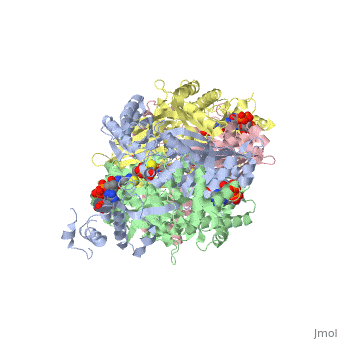From Proteopedia
(Difference between revisions)
proteopedia linkproteopedia link
|
|
| Line 1: |
Line 1: |
| - | [[Image:1dq8.gif|left|200px]] | + | {{Seed}} |
| | + | [[Image:1dq8.png|left|200px]] |
| | | | |
| | <!-- | | <!-- |
| Line 9: |
Line 10: |
| | {{STRUCTURE_1dq8| PDB=1dq8 | SCENE= }} | | {{STRUCTURE_1dq8| PDB=1dq8 | SCENE= }} |
| | | | |
| - | '''COMPLEX OF THE CATALYTIC PORTION OF HUMAN HMG-COA REDUCTASE WITH HMG AND COA'''
| + | ===COMPLEX OF THE CATALYTIC PORTION OF HUMAN HMG-COA REDUCTASE WITH HMG AND COA=== |
| | | | |
| | | | |
| - | ==Overview==
| + | <!-- |
| - | 3-hydroxy-3-methylglutaryl-CoA reductase (HMGR) catalyzes the formation of mevalonate, the committed step in the biosynthesis of sterols and isoprenoids. The activity of HMGR is controlled through synthesis, degradation and phosphorylation to maintain the concentration of mevalonate-derived products. In addition to the physiological regulation of HMGR, the human enzyme has been targeted successfully by drugs in the clinical treatment of high serum cholesterol levels. Three crystal structures of the catalytic portion of human HMGR in complexes with HMG-CoA, with HMG and CoA, and with HMG, CoA and NADP(+), provide a detailed view of the enzyme active site. Catalytic portions of human HMGR form tight tetramers. The crystal structure explains the influence of the enzyme's oligomeric state on the activity and suggests a mechanism for cholesterol sensing. The active site architecture of human HMGR is different from that of bacterial HMGR; this may explain why binding of HMGR inhibitors to bacterial HMGRs has not been reported.
| + | The line below this paragraph, {{ABSTRACT_PUBMED_10698924}}, adds the Publication Abstract to the page |
| | + | (as it appears on PubMed at http://www.pubmed.gov), where 10698924 is the PubMed ID number. |
| | + | --> |
| | + | {{ABSTRACT_PUBMED_10698924}} |
| | | | |
| | ==About this Structure== | | ==About this Structure== |
| Line 30: |
Line 34: |
| | [[Category: Nadph]] | | [[Category: Nadph]] |
| | [[Category: Oxidoreductase]] | | [[Category: Oxidoreductase]] |
| - | ''Page seeded by [http://oca.weizmann.ac.il/oca OCA ] on Fri May 2 14:08:44 2008'' | + | |
| | + | ''Page seeded by [http://oca.weizmann.ac.il/oca OCA ] on Mon Jun 30 23:27:14 2008'' |
Revision as of 20:27, 30 June 2008
|
|
| 1dq8, resolution 2.10Å ()
|
| Ligands:
| , ,
|
| Activity:
| Hydroxymethylglutaryl-CoA reductase (NADPH), with EC number 1.1.1.34
|
| Structural annotation:
|
| Resources:
| CATH : 1Dq8A03, 1Dq8A02, 1Dq8A01, 1Dq8B02, 1Dq8B01, 1Dq8B03, 1Dq8C02, 1Dq8C01, 1Dq8C03, 1Dq8D03, 1Dq8D02, 1Dq8D01
InterPro : Ipr009023, Ipr000731, Ipr002202, Ipr004816, Ipr004554, Ipr009029
Pfam : PF00368
SCOP : d1dq8a4, d1dq8a1, d1dq8b4, d1dq8b1, d1dq8c1, d1dq8c4, d1dq8d1, d1dq8d4
UniProt : P04035
|
|
|
|
|
|
| Resources:
| FirstGlance, OCA, RCSB, PDBsum
|
| Coordinates:
| save as pdb, mmCIF, xml
|
COMPLEX OF THE CATALYTIC PORTION OF HUMAN HMG-COA REDUCTASE WITH HMG AND COA
Template:ABSTRACT PUBMED 10698924
About this Structure
1DQ8 is a Single protein structure of sequence from Homo sapiens. Full crystallographic information is available from OCA.
Reference
Crystal structure of the catalytic portion of human HMG-CoA reductase: insights into regulation of activity and catalysis., Istvan ES, Palnitkar M, Buchanan SK, Deisenhofer J, EMBO J. 2000 Mar 1;19(5):819-30. PMID:10698924
Page seeded by OCA on Mon Jun 30 23:27:14 2008


